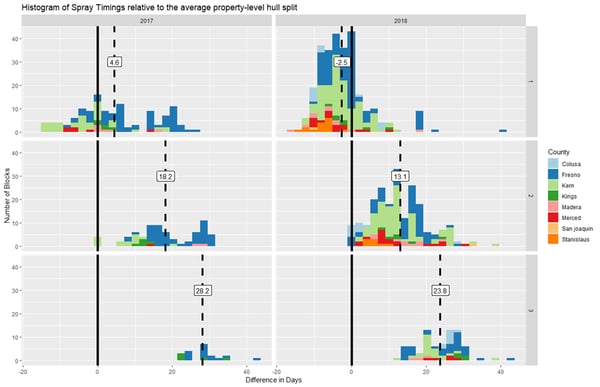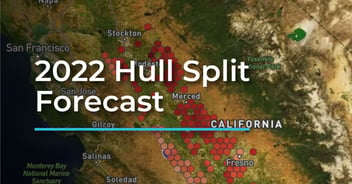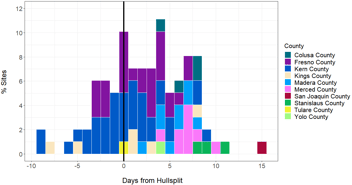With navel orangeworm (NOW) monitoring well underway in the Central Valley, it’s time to review your spray strategy for the 2021 season. While percent damage in previous seasons can give you a sense of how successful your NOW management program was, it can be hard to find the answers when things don’t go according to plan. Looking at how your sprays were timed, relative to the industry may give an indication if something is amiss in your spray program.
.jpg?width=600&name=_MG_6808%20(1).jpg)
After orchard sanitation, spray timings are critical for a successful NOW management strategy. New almond crop becomes susceptible to NOW at hull split; as nuts begin to split, volatiles are released that attract females looking for that perfect food source for their young.
This is why UC Extension recommends that NOW sprays are applied at 1% hull split, followed by a second application two weeks later. This second application coincides with pollinizer hull split, as well as when some products lose their residual effect.
Finally, when populations are high, a third spray, or sometimes even a fourth may be recommended.
While the guidelines seem simple to follow, material application decisions are not as straightforward as just spraying at hull split. Many factors come into play including logistics, the speed of hull split progression and pest development. It’s also important to keep in mind that, earlier spray applications may be needed if NOW peak flight occurs early or if rainfall is predicted around hull split.
3 Factors That Make Hull Split Applications Challenging
- Variability across a ranch
Hull split doesn’t always happen uniformly across a property. Some growers can even experience a 7-day range in hull split forecasts from one block to another. Knowing where hulls will split starts can help you know where to send your rigs first.
Figure 1 below shows a California customer’s predicted hull split on a per acre level. You can see the west side of the property is expected to split first, July 7, while the east side is forecast to split a week later on July 15. - Irrigation challenges
It’s essential to ensure your field is dried out enough to get spray rigs through without creating ruts or getting stuck. Having advanced notice of when your hulls will split will ensure you plan irrigation accordingly. - Logistics
Getting enough spray rigs to do the job in a timely manner can be tough. The more notice and the more insight you have as to where hull split is going to hit first can help you optimize your spray plan for maximum efficacy.

Figure 1 - Per Acre Hull Split Forecast
These factors all impact effective spray timing. 2017 was a year of heavy NOW damage partially because of poor sanitation due to heavy winter rainfall but spray timing may also have played a part. The chart below shows when growers applied sprays relative to hull split (Figure 2) in 2017 and 2018; two hull split sprays and the third if applied.
Many growers were unable to make timely hull split sprays in 2017 due to the high amount of rainfall which prevented equipment from entering the fields. In 2017, growers applied the first hull split spray on average 4.6 days after hull split. In contrast, in 2018, most growers applied their NOW sprays before hull split, with growers applying hull split sprays on average 2.5 days before hull split. 2018 was reported as having less NOW damage compared to 2017.

Figure 2. State-wide hull split spray timings relative to non-pareil hull split for the sprays 1 - 3
Checking Your Work - Use the Semios Almond Management Tool

Figure 3. Semios spray timing tool. (1) Block specific hull split (2) Trap captures (3) Average hull split application times (4) Hull split application times relative to hull split
Compare Your Spray Timings With The Rest Of The Industry
With Semios' spray timing feature shown in Figure 3:
- See block-specific hull split times (1)
- Overlaid onto trap captures (2), showing how well their NOW flights and sprays lined up to hull split
- The dotted lines (3) indicate the industry average of hull split spray timing
- The shaded areas (4) show the full spectrum of spray timing
How to Evaluate Your Hull Split Spray Program
- Are your hull split predictions far enough in advance to plan sprays?
- How are your spray resources being allocated? (e.g. high pressure blocks, high value crop/cultiver/nut type)
- Are you choosing the right product based on application timing?
- Does your spray program align with NOW activity in your orchard?
Need help? Our entomologists and PCAs can help. Fill out the form below and we'll be in touch.
References:
How Much Does Navel Orangeworm Damage Cost?
Related Posts:
2021 NOW Trap Catch Update
Why You May Want To Rethink Hull Split Applications At 1700 Degree Days
Comparing Degree Day Sources For Tracking NOW Generation Flight Prediction



